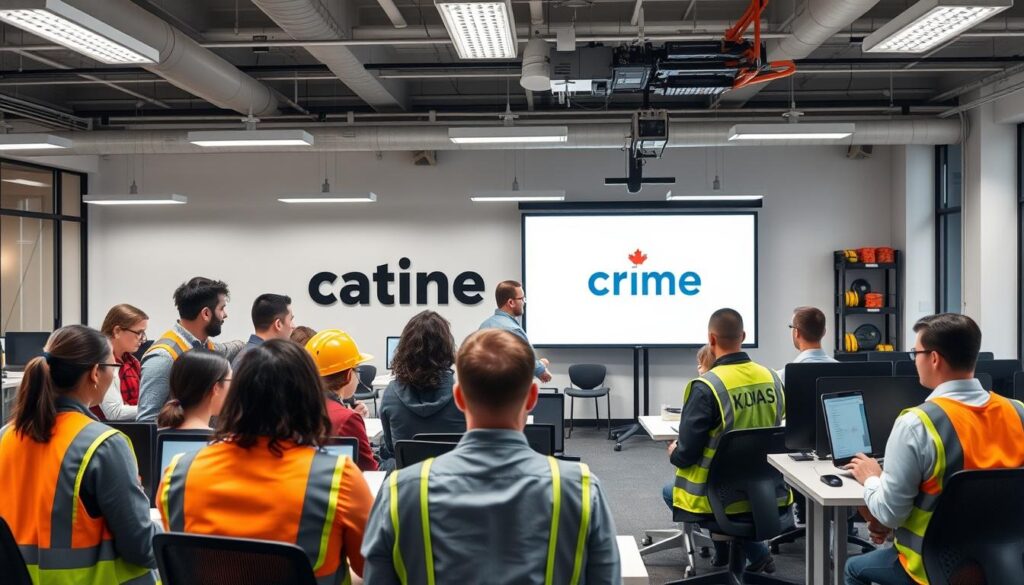In Canada, over 75% of workplace incidents causing serious injuries or death last decade were due to criminal negligence. This highlights the need for both businesses and individuals to stay alert. Facing severe legal penalties and causing harm to others can be the consequences.
This guide will show you how to dodge these issues. It covers understanding criminal negligence, following safety rules, and keeping detailed records. Armed with these tips, you’ll know how to keep things safe and follow the law.
We will now look into avoiding legal trouble. This includes meeting your legal duties, setting up strong safety processes, and writing down everything properly.
Understanding Criminal Negligence
In Canada, criminal negligence refers to actions or lack of action that show a clear disregard for other people’s lives or safety. It’s based on specific rules in the crime code. Knowing what these actions are is very important to avoid breaking the law.
What Constitutes Criminal Negligence in Canada?
Criminal negligence in Canada is wide-ranging. It includes acts of harm and not acting when you should. It’s about showing a careless lack of concern for the well-being of others.
Common Examples of Criminal Negligence
Different situations can show criminal negligence. For example, if companies ignore safety rules, accidents can happen at work. Or, if drivers don’t follow traffic laws, they might cause crashes. These examples help us understand more about crime in Canada.
Relevant Sections of the Canadian Criminal Code
The Canadian criminal code clearly defines what is considered criminal negligence. Sections 219 to 221 give those legal definitions and boundaries. Knowing them can help stop us from doing something that could have serious effects.
Legal Responsibilities and Duties
Understanding your role and the legal responsibilities in negligence is crucial. It helps protect people and organizations from the consequences of criminal negligence. This part explains the duties you need to follow and the risks of not meeting these obligations.
The Duty to Act: Legal Obligations
You must take steps to keep others safe. This applies in places like work, public areas, and in private. Doing so prevents harm and keeps you from legal trouble.
Potential Consequences of Failing to Meet Legal Duties

If you ignore your legal duties, the results can be serious. You could face big fines or even jail. Also, your reputation and ability to work in your profession could suffer for a long time.
Implementing Effective Safety Protocols
Keeping employees safe helps avoid serious legal issues. Strong safety plans keep your company in line and boost safety at work.
Developing Standard Operational Procedures
Start making a safe workplace by crafting detailed standard operational procedures (SOPs). SOPs set clear steps for everyday work and emergencies, making sure everyone is safe and knows their jobs. This way, you lower accident risks and make sure all employees know what they need to do.
Regular Safety Drills and Training
It’s key to have routine safety training and drills too. These help make sure safety rules are second nature to your team. Trainings cover using safety gear, spotting dangers, and more. Using real situations in drills makes them even better.

Keeping up with safety training and using realistic drills can really lessen workplace accidents. As the Crime Severity Index shows, a secure workplace also means less crime nearby.
Focus on creating good SOPs and continuous safety training. This builds a safety-minded culture that keeps everyone safe.
Maintaining Comprehensive Documentation
Keeping detailed records is vital to avoid and defend against criminal negligence charges. Your group must keep up with both paper and digital records. These need to be easy to get to and well-kept. Doing so ensures openness and responsibility, especially in legal situations.
Importance of Paper and Electronic Files
It’s very important to keep paper and digital records accurate. This not only avoids legal troubles but also makes operations run smoother. Good record-keeping means you have all the needed info ready, defending well against negligence claims.
Add an effective digital file system to make managing records easier. This reduces the chance of losing important papers. It makes sure all info is current and reachable with ease.

Best Practices for Documentation
Following top documentation methods can really lower the risk of facing criminal negligence. Here are some critical tactics:
- Regularly update files: Keep all records, both paper and digital, reviewed and refreshed to show any changes.
- Secure storage: Keep all documents in safe, organized spots. For digital, use encrypted storage.
- Accessibility: Let authorized people get to needed records easily. Set strict rules to keep out unwanted access.
In comparing paper and digital record-keeping:
| Aspect | Paper Files | Electronic Files |
|---|---|---|
| Accessibility | Limited to physical location | Accessible from any authorized device |
| Storage Space | Needs physical room | Uses digital space, usually more compact |
| Security | Can be lost or damaged easily | Secured with encryption and backups |
| Update Efficiency | Needs manual updates | Can be updated automatically |
To wrap it up, practicing effective documentation and digital record management is key. These steps not only prevent legal troubles but also boost your group’s efficiency and order.
Tips to Prevent Criminal Negligence
Keeping your workplace safe and following the rules is key. You can do this by being proactive and creating a safety-first culture. This helps you manage and lower risks.
Risk Assessment and Management Strategies
It’s important to use negligence risk management strategies to spot hazards. Start by doing a deep dive to find weaknesses in your operations. Then, put strong strategies in place to lessen criminal negligence risk.
- Conduct regular risk assessments to uncover unforeseen dangers.
- Develop comprehensive risk management plans to address identified issues.
- Incorporate feedback from all levels of staff to ensure exhaustive evaluations.

Employee Training and Awareness Programs
It is crucial to keep training your team. By doing regular training, they’ll understand safety rules and negligence risk management better.
| Training Aspect | Frequency | Benefits |
|---|---|---|
| Initial Orientation | Once | Basic understanding of organizational policies and safety procedures. |
| Monthly Training | Monthly | Up-to-date with current safety practices and protocols. |
| Annual Reviews | Annually | Periodic review and reinforcement of safety measures and updates. |
Regularly having training sessions makes a big difference in reducing the risk of criminal negligence in your workplace. Keeping employees up to date promotes a safe and responsible work environment.
Conducting Regular Audits and Inspections
Regular safety audits and inspections are key for a safe workplace. They help spot potential hazards and check if safety rules are followed.
Scheduling Routine Safety Checks
Safety checks should be scheduled often. This makes sure your workplace meets safety standards. Doing regular audits finds and fixes problems quickly, building a safety-first culture.
Utilizing Third-Party Auditors
Hiring external auditors gives an unbiased look at your safety steps. They spot problems that might be missed internally. Using these experts shows you’re serious about safety and adds trust to your reports.

Adding these steps to your safety plan shows you actively manage risks. Regular, fair audits from outside help make your workplace safer. They reduce dangers and make sure rules are followed.
Establishing Clear Communication Channels
Communication strategies are key in avoiding criminal negligence at work. It’s crucial that every employee understands safety procedures. This starts with clear and important communication in the workplace. By keeping communication open, a culture of safety is built where messages about safety are always understood and followed.

Setting up communication strategies means making different ways to communicate that meet various needs. This can involve:
- Employee meetings and briefings
- Internal newsletters and bulletins
- Digital platforms for information sharing
Using a planned method for communicating at work means safety protocols are continuously emphasized. Updates or changes are shared immediately. This practice keeps a high standard that avoids mistakes and makes a safer work environment.
Open communication also creates a place where workers feel safe to share concerns or point out risks. Taking an active approach to communication boosts safety. This matches the important points of an effective system found in the UNODC handbook.
Below is a table that compares different communication strategies and their advantages:
| Communication Strategy | Benefits |
|---|---|
| Employee Meetings | Immediate feedback, clarification of doubts |
| Internal Newsletters | Regular updates, record-keeping |
| Digital Platforms | Quick distribution, accessibility |
By applying these communication strategies at work, you improve how people talk and listen to each other. This highlights how vital clear and effective communication is in preventing negligence.
Using Technology for Prevention and Monitoring
Using new technologies is key to keeping up with safety rules and lowering negligence risks. Tools like safety management software and live monitoring are top methods in today’s safety measures.

Utilizing Management Software
Safety management software makes following safety rules simpler. It helps in organizing documents, improving talks, and keeping safety steps consistent. This software offers detailed reports, helping spot risks early and deal with them quickly.
Real-Time Monitoring Tools for Safety Compliance
Real-time monitoring tools keep safety standards high. They watch over workplace conditions without pause, catching safety problems as they happen. Using tech for safety helps make workplaces safer and lowers the chance of facing negligence charges.
Learning from Past Incidents
Studying legal cases where companies were charged with criminal negligence is very useful. These situations show why it’s crucial to follow safety rules and legal duties to avoid similar problems. Let’s look into some major criminal negligence case studies to learn and improve business practices.
Case Studies: R v Metron Construction Corporation
The Metron Construction Corporation case is a key study in corporate negligence. In December 2009, a swing stage broke in Toronto, causing the death of four workers and injuring another. The accident was due to poor safety practices and harmful substances found in the workers’ bodies. As a result, the company was charged under the Criminal Code of Canada for not keeping the workers safe.
The court fined the company $750,000. This was a landmark decision for safety and responsibility in construction. It shows companies that being careless can lead to big legal and financial troubles. This stresses the vital need for strict safety measures and following the law.
Case Studies: R v Stave Lake Quarries Inc.
The R v Stave Lake Quarries Inc. case is another important example. A landslide at the quarry in 2016 caused a worker’s death. Poor safety and risk assessment were the main reasons. The company was charged with criminal negligence for not ensuring a safe workplace.
A fine of $100,000 was imposed on Stave Lake Quarries Inc. This highlights the necessity of learning from negligence cases to improve workplace safety. Better training and regular safety checks might have prevented this sad event.

By studying criminal negligence case studies, firms can learn how ignoring safety and legal rules can lead to terrible outcomes. These stories are warnings, pushing businesses to adopt stronger safety measures. This way, they can keep their workers safe and avoid breaking the law.
Conclusion
To avoid legal trouble, it’s key to follow best practices in legal compliance. Knowing the law, especially in Canada, teaches you your duties and what could happen if you don’t uphold them. This article pointed out important things like understanding criminal negligence, following safety steps, doing regular checks, and using technology to watch things closely.
For a safe and legal workplace, good communication, detailed records, and ongoing staff training are vital. Studying past mistakes helps us learn how to avoid making them again. This shows how important it is to always be alert and manage things well.
Using these guidelines and always trying to do better keeps your work safe and legally sound. Preventing criminal negligence is a never-ending task that needs hard work and focus on details. By staying informed and ahead of issues, you protect your business and build a workplace that values safety and responsibility.

